“Japanaroo” is an exciting new initiative allowing people to celebrate multiculturalism and exchange with Japan in Australia.
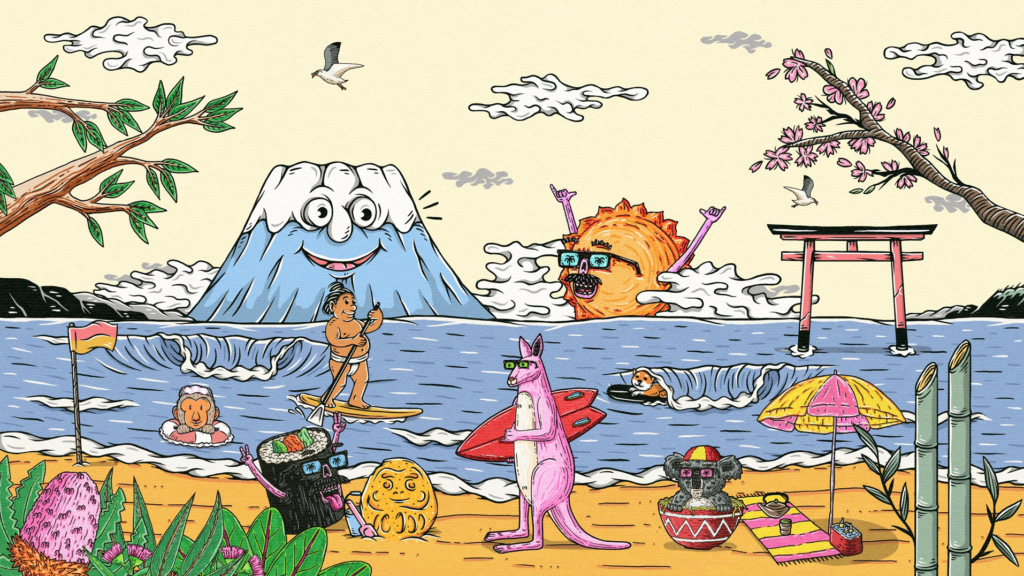
“Japanaroo” is an exciting new initiative allowing people to celebrate multiculturalism and exchange with Japan in Australia.

The tea ceremony moves with each season. The host considers it when preparing each element of a tea ceremony: the hanging scroll, the flower arrangement, the tea bowls, what to wear (especially if the host is a woman), the incense, and the wagashi (Japanese sweets) to serve before the tea. In Japan, kumpu kaze minami yori kitari (the fragrant wind comes from the south) is a popular scroll in late May (Hounsai Daisosho himself produced a hanging scroll with this short verse).
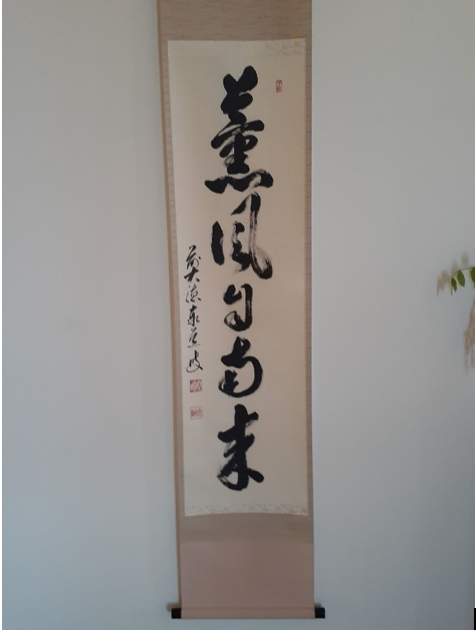
The verse on this member’s scroll is from a poem by Su Dongpo (東坡,1037 – 1101), a calligrapher, gastronome, painter, pharmacologist, poet, politician, and writer in Song dynasty China. However, the history of the verse goes back much further, to when Emperor Wenzong (809-840) of the Tang dynasty said: “everyone loves the long summer day, even if they suffer from heat stress”. The poet Liu Gongquan (778–865) added a line referring to relief from the cool southern wind.
Two hundred years later, Su Dongo wrote that the verse illustrated a lack compassion for the common people on the emperor’s part, and he re-wrote the verse in the form:
Kumpu minami yori kitari
Denkaku biryo o shozu
The balmy summer breeze comes from the south,
It becomes a bit cooler in the palace.
This is still hard for a tea novice to understand. The full meaning comes from the interpretation that Zen masters put on the verse. Every day we are obsessed with our problems, but if only we only allow these to be blown away by the scents of a refreshing spring breeze then we can taste enlightenment.
Su Dongpo lived in the west of China, in what is now Sichuan province. His verse is clearly about summer. However, in Japan the verse is popular in May and June when on fine days there is often a light breeze from the south, kumpu. In European tradition it is a west wind, or zephyr. In Sydney, the equivalent is a sea breeze in summer.
The 50th anniversary of the Association will be in 2023. However, the history of chado in Sydney goes back a hundred years, and we should perhaps ask why a group did not emerge earlier. In the United States, several chado associations emerged before World War II. In Australia, an Englishman, Arthur Lindsay Sadler (1882-1970) was pre-eminent in chado from the 1920s.
Sadler arrived in Japan in 1909 to teach English at the Sixth Higher School, Okayama, one of the predecessors of Okayama University. In 1918 he moved to Tokyo to teach English at the Peers’ College (1918-21). His wife Eva had an English father and a Japanese mother. By 1921, he was a great scholar, accomplished in Hebrew, Assyrian, Greek, Latin, Sanskrit, Mandarin, and Japanese. He had an extensive knowledge of Japanese and Chinese history and art. In addition to his teaching, Sadler was an enthusiastic collector of Japanese woodblock prints, samurai armour, ceramics, scrolls, swords, and theatre masks.

Prof. Sadler introduced tea ceremony to Sydney. Between 1926 and 1929, he built a teahouse in the garden of his home at Warrawee in Ku-ring-gai, and in 1929 he wrote a paper on tea ceremony. In May 1932, photographs of the garden featured in The Home, an Australian quarterly. Sadler often invited his students and friends to tea in the tea house.
In 1933 Sadler published two books, The Art of Flower Arrangement in Japan and Cha-no-yu: The Japanese Tea Ceremony. Okakura Kakuzo’s The Book of Tea (1904) is usually referred to as the first book about tea ceremony written in English (the Japanese know Kakuzo as Okakura Tenshin). It was published in New York. However, as Sadler points out, it is an essay rather than a book. This is not to suggest that Sadler was dismissive of Kakuzo’s work, in fact the opposite was true. Sadler simply aimed to write a detailed account. In 1935, Angus & Robertson published in Sydney a second edition of Kakuzo’s “essay” with an Appendix by Sadler. That Angus & Robertson should publish this in Sydney is indicative of interest in chado within the Australian community. So, the first full-length book on chado written in English originated in Sydney! It is still a must-read for chado enthusiasts lacking a Japanese background, especially members of our Sydney Association. It is easily bought through Amazon, Kindle, and the like.
Sadler retired as Professor in 1947. The tea house was demolished and the Sadlers went to live in England. Accordingly, Sadler sold much of his collection. Among the few items that are still traceable is a suit of samurai armour now in Sydney’s Powerhouse Museum.
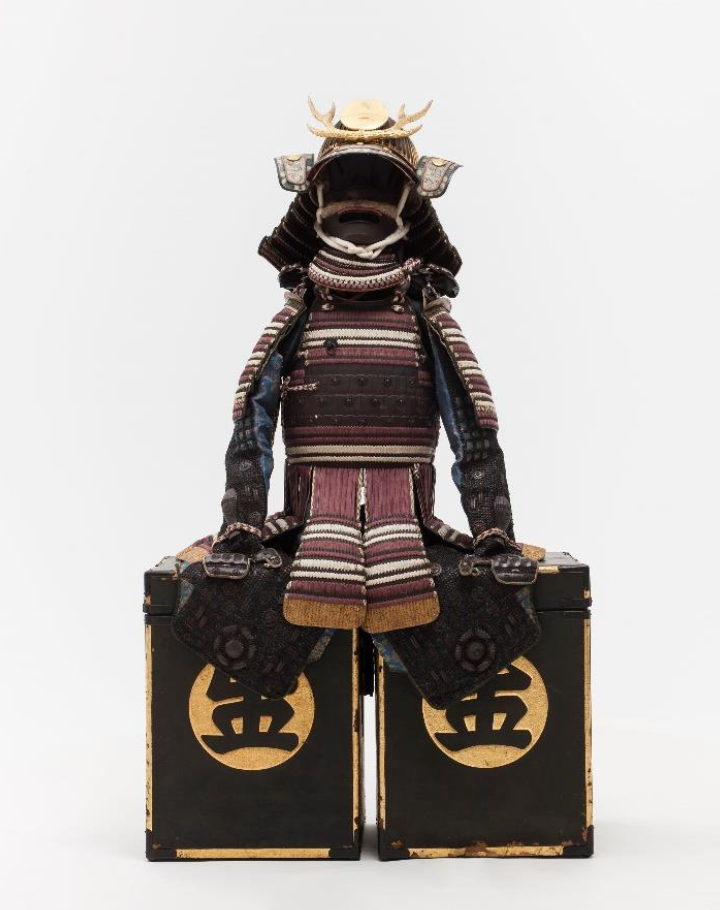
According to the Powerhouse Museum, the previous owner is unknown. However, it is from Sadler’s collection. The Museum states that the armour bears an insignia “claimed to be that of Koma Kaemon, Samurai officer of the Bizen clan” but does not say who made this claim. Possibly, it was Sadler himself, with the claim stated on the auction list. Moreover, Bizen is in Okayama prefecture, where Sadler lived for nine years after arriving in Japan in 1909. The suit of armour may even have been the start of Sadler’s interest in Japanese history and chado. Anyway, it seems no one has yet bothered to investigate the suit of armour, so do any of the Association’s members have any thoughts?
Urasenke Sydney has donated $800 to the Cowra Japanese Garden and Cultural Centre. The Centre supports cultural exchange between the peoples of New South Wales and Japan. The special relationship of Cowra (road distance from Sydney 306km) and Japan dates from August 1944, when 1,104 prisoners of war attempted to escape. It was the largest prison escape of World War II, as well as one of the bloodiest. Due largely to cultural differences, relations between the Japanese prisoners and the guards had been poor. During the escape and ensuing manhunt, 4 Australian soldiers and 231 Japanese soldiers died. In 1960 the Japanese Government decided to bring all their war dead from around Australia to be re-buried together in one place. In 1962, Japanese Embassy officials, impressed with the attention paid by local Australians to the graves of their war dead, approached the Cowra Council to discuss the possibility of one cemetery for all Japanese who had died on Australian soil during the war years and for that cemetery to be located in Cowra. So, in 1964, a Japanese War Cemetery, designed by Shigeru Yura, was built. High school students maintain the cemetery. This was the beginning of the friendship between Japan and the town of Cowra. For years, Urasenke Sydney has given chado demonstrations at the annual sakura matsuri (cherry blossom festival) in the Japanese garden and donated its proceeds (see photographs below).
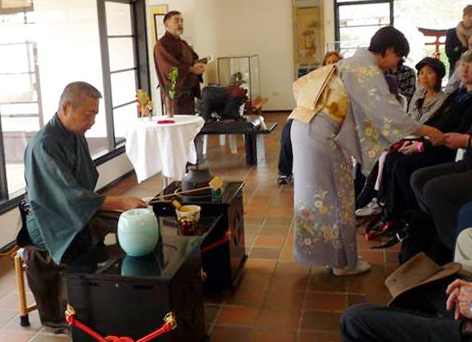
This year, Covid-19 meant that the sakura matsuri festival could not take place, but Urasenke Sydney felt it vital to maintain our support for the Centre. In fact, Japanese chado practitioners visited Cowra as early as 1970, before Urasenke Sydney came into being.
There are Japanese gardens throughout the world, but this one has a history, design, and location that make it a powerful symbol of good will, encouraging reconciliation and peace. The Cowra Japanese Garden covers five hectares. The renowned landscape architect Takeshi “Ken” Nakajima中島健 (1914-2000) created this daikaiyū-skiki-teien, 大回遊式庭, “great strolling-style-garden” to symbolise the Japanese landscape (”Ken” is an alternative pronunciation of 健 to Takeshi). The rocky hillside, manicured hedges, waterfalls, streams and two lakes provide a serene and secure environment for more than 120 species of birds. Plant species include: flowering cherry, cedar, rose, persimmon, downy maple, flowering quince, liquid ambers, golden ash, maples, Chinese tallozvs, silver birch, wattles, jacarandas, magnolias, camellias, lilacs, honeysuckle, rosemary, bamboo, dwarf diosma, crepe myrtle, daffodils, irises, may bushes and jasmine. The huge scale of the garden and of the shakkei, the “borrowed scenery” of the Lachlan valley, 借景, make for a magnificent outcome. According to Nakajima’s son Hiro, Cowra is his father’s finest work.
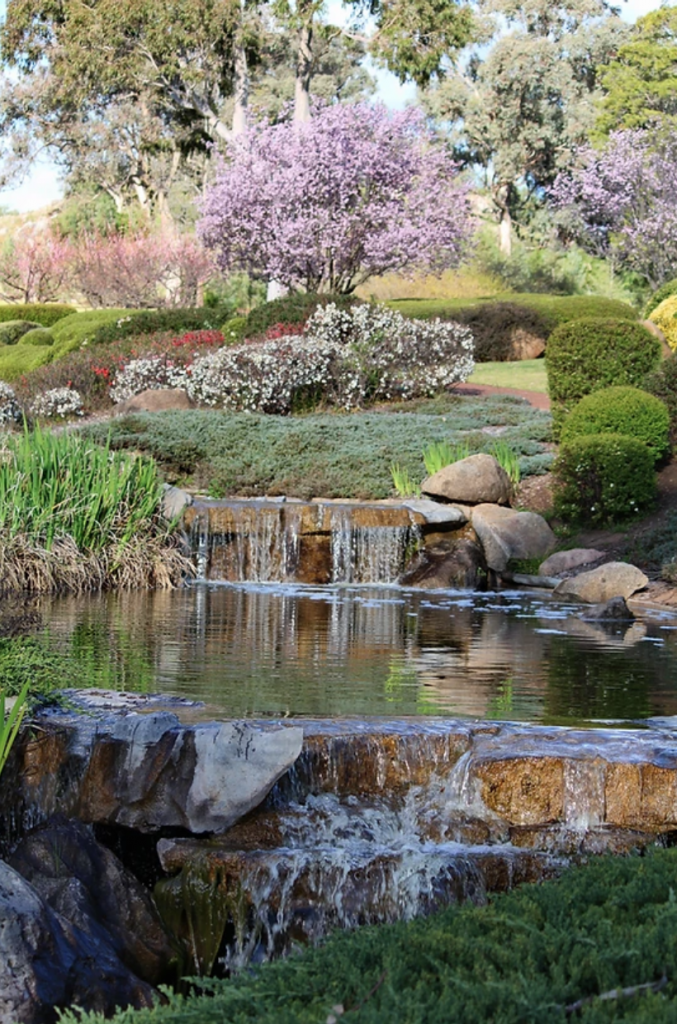
In the National Archives of Australia (NAA), we have discovered three 1967 photographs of chado lessons. We believe that these are photographs of the earliest chado lessons in Australia. We are reproducing the three photographs in the hope that others may be able to shed more light on them.

The photographs were taken by R W Nicol for the then Australian News and Information Bureau, a Commonwealth government agency. By searching on the internet, we found that Nicol was an amateur photographer active in Brisbane. So, we contacted Akiko Yamada in the Urasenke Brisbane Liaison Office. She identified the teacher in the photo below as Mineko Furusawa AM OAM. Mineko received her OAM in 1987 for service to Australian/Japanese relations, and her AM in 2001 for service to Australian-Japanese relations, particularly in relation to educational exchange programmes.
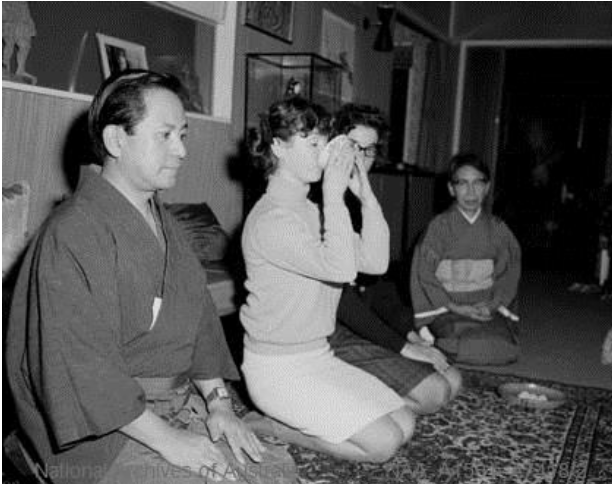
Akiko Yamada is now making enquiries to try to identify the others in the photographs. We have asked NAA and the Kobe Japan Australia Society for help in further research about the amazing life of Australia’s first teacher of chado, and her love of Australia. She was born in Taiwan in 1910.
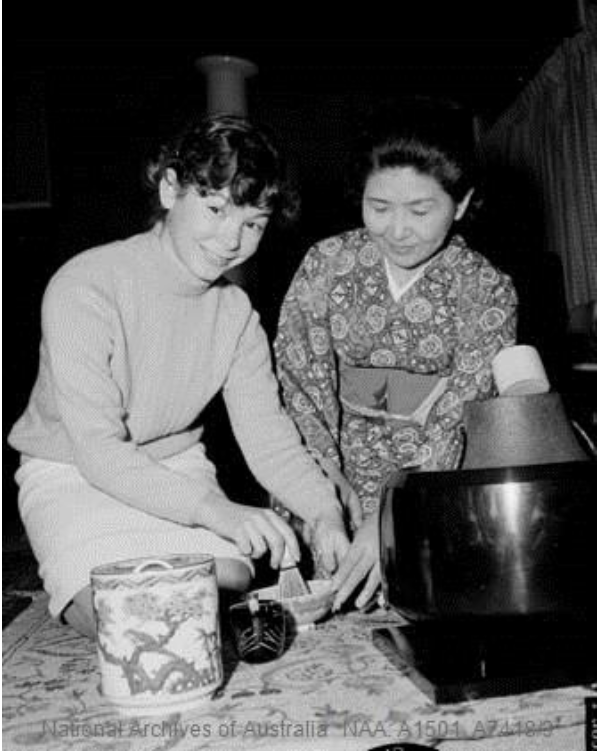
Please let the Association know if you have any information that may be relevant to this story.
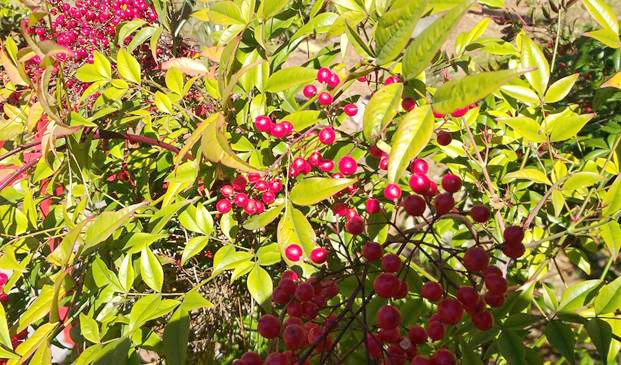
Nan-ten, 南天, is one of several plants associated with tea houses that Australian governments regard as environmental weeds. The photograph was taken in the garden of one of two Association members who have been found to be growing this environmental weed. Nan-ten means “southern sky.” However, in Japanese, nan-din, 難点, sounds like nan-ten but means difficult point or misfortune. For centuries it was planted in the north-eastern corner of gardens or by the gate to ward off evil spirits.
The scientific name is Nandina domestica Thunb. The famous Swedish naturalist, Carl Peter Thunberg, Latinized nan-ten to Nandina. Due to his medical and scientific reputation, Thunberg got the opportunity in 1776 to accompany the Dutch ambassador to the shogun’s court in Edo. During the journey from Nagasaki (where Thunberg was the head surgeon in the Dutch factory) to Edo, the Swede collected specimens of a great many plants and talked to Japanese locals in the villages along the way. In 1784, Thunberg wrote one of his scientific masterpieces, the Flora Japonica.
The epithet domestica reflects the frequent planting of nan-ten in gardens in Japan, and in Japanese-style gardens throughout the world. When planted next to houses and doorways, it is seen as a “home shrub,” serving to protect a household from harm. “Sacred bamboo” was also cut for use in traditional decorations. Its leaves, flowers and berries were used in ikebana. Another type of decoration, known as kadomatsu (literally “gate pine”), was used to celebrate the Japanese New Year. It combined Japanese black pine branches and the thick stems of true bamboo, cut at a sharp angle to reveal their hollow interiors. Nan-ten foliage and berries were often included. Such arrangements were usually placed on both sides of a doorway or gate. There, they would serve as a temporary home for the kami (gods) that bring abundant crops and good fortune to the household. Sprigs of nan-ten are used to garnish osechi ryori (New Year dishes).
In Europe, holly, Ilex aquifolium, has similar cultural uses in mid-winter to Nan-ten. Like Nandina, Ilex aquifolium has red spherical berries contrasting with green leaves. The hardy plant’s ability to stay vibrant through winter made it a natural choice for pre-Christian winter festivals. The Roman feast of Saturnalia, celebrated at the darkest time of the year, celebrated the god of agriculture, creation, and time, and the transition into sunshine and spring. Roman citizens festooned their houses with garlands of evergreens and tied cheery holly clippings to the gifts they exchanged.
For the Australian gardener, nan-ten has many attractions. It is adaptable, hardy, and without major pests or diseases. It tolerates full sun or part shade, and it is drought-tolerant once established. The appearance is interesting in all seasons, even without berries. The young leaves in spring are brightly coloured pink to red before turning green; old leaves turn red or purple again before falling. In early summer, it blooms with lots of white rice-like florets. It is easy to propagate because it sends out lots of runners.
Nan-ten has long been available in Australia for gardeners. In 1875 a Victorian nursery was advertising plants for 1s. 6d each, or about $3.50 in today’s prices. Unfortunately, several Australian governments now classify nan-ten as an environmental weed. According to the Queensland state government: Sacred bamboo (Nandina domestica) is regarded as an environmental weed in New South Wales and as a potential environmental weed or “sleeper weed” in other parts of Australia (i.e. Victoria and Queensland). This species is currently of most concern in the wider Sydney and Blue Mountains region in central New South Wales. It is currently not very widespread or common, but its abundance and range is increasing. Sacred bamboo (Nandina domestica) is listed as an environmental weed by the Blue Mountains City Council, and it is occasionally found in bushland edges and along drainage lines in this region. It has also been recorded in conservation areas in the Blue Mountains (i.e. Tunnel Gully Reserve) and in suburban Sydney (i.e. The Lakes of Cherrybrook in Hornsby Shire).
Visitors to the Dubbo Regional Botanic Garden will find that nan-ten has been planted near both gates to the Japanese tea garden and in the sensory gardens. It seems Dubbo Regional Council is unaware of the weed problem that other Australian local and state governments are facing.
